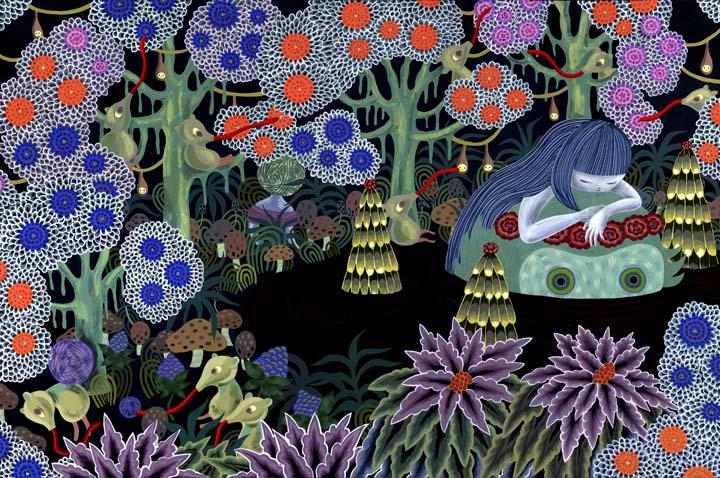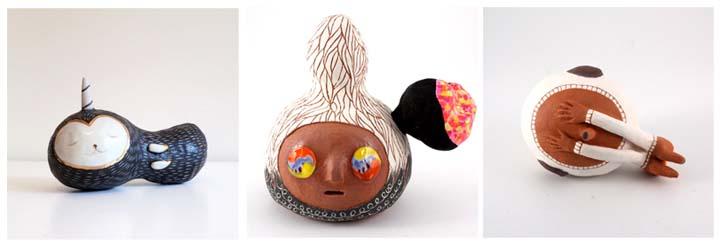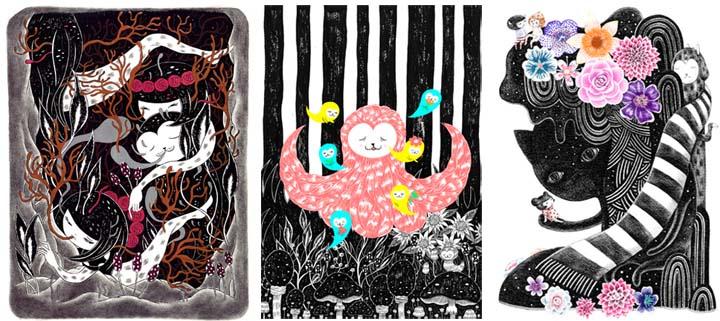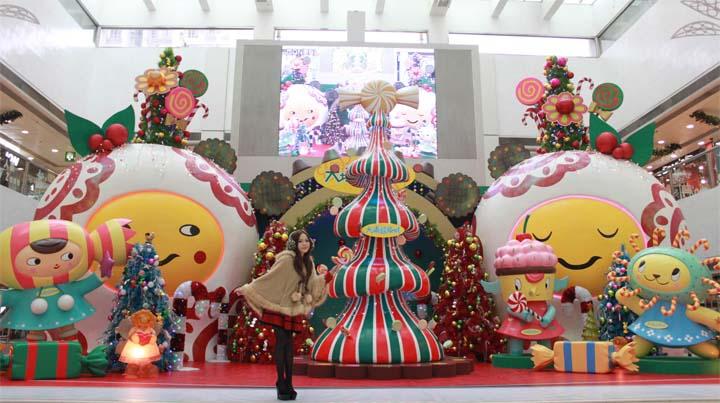The Q&A: Aya Kakeda
Q: Originally from Japan, what are some of your favorite things about living and working in Brooklyn?
A: My favorite thing about New York is the people—my friends from multicultural backgrounds, and the artist community here. Sounds very ordinary to say, but New York is full of surprises. I love Tokyo because everything works efficiently, the train comes on time and is clean, the products are beautifully made and packaged, and the toilet seats are warm. I feel pampered and protected there.
New York feels quite the opposite. The train’s not clean and doesn't run on time, and it’s full of people from different countries who have different standards and different tempos. I’ve learned how to keep my own tempo here. The random clutter and out-of-order quality inspires new and interesting ideas. Although New York City does not inspire a peaceful mind, for me NYC is inspirational and Japan is peaceful. Going back and forth keeps everything in balance.
Q: Do you keep a sketchbook?
A: I have no impressive sketch books, like some of my
friends. I keep some text and doodles for project ideas. I have piles of random, unfinished sketchbooks lying around that I take on trips or a long commute. They are not chronological and I skip
pages so it's kind of like a time machine—a page from 2004 could be next to one from 2010. It’s very random. Sometimes it's nice to encounter my past ideas this way—it might
become the inspiration for a new idea.
Q: What is the balance between the art you create on paper versus in the computer?
A: 90% paper vs 10% computer
Q: What is the most important item in your studio?
A: I have multiple work places: my home studio where I do my personal work, my illustration studio to work on assignments, and a ceramic studio to make my sculpture. I can’t think of a specific, important item other than space itself and how each place is set up the way I most feel comfortable working in.
Q: What do you like best about your workspace?
A: When I'm in Tokyo my studio is in my grandmother's tea ceremony room. There is a one huge desk in a tatami room that doesn’t have internet and is extremely quiet. There I can really concentrate; it feels like a little hide out for me. I'm trying to recreate that space in my home studio in Brooklyn. I have a large room with one desk that’s quiet and surrounded by my plants. That quietness and the emptiness is what I love about this studio.
In contrast I really like my illustration studio where I work with five other studio mates. Here I can have conversations and exchange ideas. Seeing what they are making is inspirational. The social aspect is the best about this studio. I feel like they are my NYC family.
And the last is my ceramic studio. It's an old building and we each get small table to work at. Most of the people there are ladies who are over 60's (one lady is 93 years old!). They have funny stories about living as New Yorkers for such a long time. So when I go there I feel like I'm in a Woody Allen movie. Those ladies’ stories are the best about this studio. Making work while listening to them is my secret pleasure.
Q: How do you know when the art is finished?
A: It’s probably a very natural intuition. Whenever I made something as a kid, when I knew it was done, I screamed Dekita!!!! and did a little dance shaking my butt like a dog. This feeling of excitement and joy running through my body and tells me when the art is finished.
Q: What was your favorite book as a child? What is the best book you’ve recently read?
A: I always loved books that had funny characters and/or animals. I also liked adventure stories. Some of my favorites are children's novels by Ruth Stiles Gannett, the Moomin series by Tove Jansson, the Doctor Dolittle series by Hugh Lofting, and novels by Michael Ende. I recently read "The Summer Book" by Tove Jansson which made me think of a time with my own grandparents. It was nice to revisit her novel since I was so into reading her Moomin series as a child.
Q: If you had to choose one medium to work in for an entire year, eliminating all others, what medium would you choose?
A: Clay. There are set materials that I love using—gouache, brush pen, silkscreen, and embroidery. I learned to use them well so I see them as great tools. But clay and ceramic glazes are still a big mystery to me. The things I make never come out as I plan. It is both frustrating and exciting. And the surprise aspect of it is addictive.
Q: If you could time travel to any era, any place, where would you go?
A: I would love to visit 1903 New York to see original Luna Park in Coney Island. I would rescue Topsy the elephant.
Q: What is preoccupying you at the moment?
A: An idea for multiple new series of sculptures and installation. (And which friends to ask to model for this project.)
Q: What are some of your favorite places/books/blogs/websites for inspiration?
A: I find inspirations from random things like the mysterious rock formation I see in my neighbor's back yard, strange conversations with strangers, weird sculptures at a stoop sale, beautiful fabrics and crafts, and stories of strange rituals from different cultures.
Those inspirations usually are tucked away in my brain and they often come back when I'm watching a moving image with no words and I doze in and out between my imaginary world and the real world. It’s like when I'm on a long train, bus or car ride and watch the changing scenery, or when I'm watching dancers at the theater and following dancers’ movement. Oh, and sometimes when I'm chopping vegetables very small I get a good ideas.
When I need inspiration for a character design I look through funny animals photos (English Angora, Star-nosed mole, Dumbo octopus, Japanese dwarf flying squirrel, Venezuelan poodle moth), vintage costumes, and Halloween photos. In New York I go to Film Forum, Anthology Film Archives, New York Image Library, Metropolitan Museum, American Folk Art Museum, Natural History Museum, Kinokuniya Book Store, and Brooklyn Academy of Music. Also, but a bit far, I like the Museo JugueteAntiguo (Mexico City), Museo de Arte Popular (Mexico City), International Folk Art Museum (Santa Fe). I get so much inspiration from these places. If I lived near them I would definitely go when I needed inspiration!
Q: What was the [Thunderbolt] painting or drawing or film or otherwise that most affected your approach to art?
A: New thunderbolts keep striking since there are so many new paintings, films, books, and cultures to discover. But as a child I remember being so into a puppet theater of Elmer and the Dragon, also watching new Miyazaki and Disney animations, and reading about Japanese Yokai and ghost stories. As a young mind my kaboom moment was seeing a retrospective of Annette Messager and also watching a Emir Kusturica film "Crna Macka, Beli Macor." Also in my early 20's I joining the artists collective Flux Factory and that really changed my art. Working in teams with non-visual artists like writers, philosophers, and historians opened up my whole view of what art is and loosened my sensibilities a lot during these collaborations.
Q: What would be your last supper?
A: Will I still have teeth? I hope I live long but I have no idea what I would like eating then. If today would be my last supper, I want my friend Hiroshi Kitano to cook me a full course Japanese meal!
Aya Kakeda was born and raised in Tokyo Japan. She now works and lives in Brooklyn, New York. She likes cats, seals, and
receiving postcards and she has ever changing weekly obsessions, now it's Clavariaceae and the star-nosed mole. She also elaborates lots of theories about lot of things. When she
doesn't indulge in her obsessions she paints and draws, creating her own whimsical narratives.
Aya is part of these arts collectives:
FLUX FACTORY
PAOPAO
Rice Appreciation ClubHouse
Penpals









